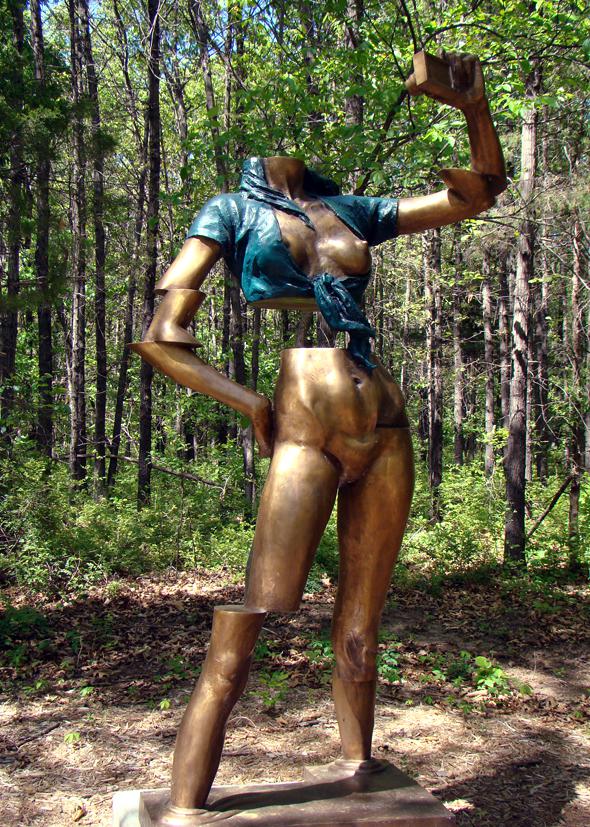In the city of Overland Park, Kan., a grand jury may soon criminally investigate a sculpture.
The bronze sculpture, installed in the Overland Park Arboretum, shows a headless, bare-breasted woman photographing herself. Artist Yu Chang may have intended it as a criticism of sexting, but the American Family Association of Kansas and Missouri sees his work as obscene. In a video made in protest, the group breathlessly describes the sculpture’s “fully nude, aroused breasts.” On its website, the AFA suggests the sculpture promotes “children manufacturing child pornography.”
In most states, this might merit nothing more than a mention in the local paper. And not everyone in the area, part of the Kansas City suburbs, is concerned. But officials have been forced to take the protest seriously because of a quirk in Kansas law that’s being exploited by conservative culture warriors. Kansas is one of six states that permit citizens to empanel grand juries. And it has recently changed that law to further reduce the influence of a professional prosecutor. As a result, Overland Park officials have already spent about $35,000 to defend the sculpture from criminal charges—and the fight is by no means over.
Grand juries investigate whether there’s enough evidence to charge someone with “a capital, or otherwise infamous crime,” as the Constitution states—generally a felony. In most areas, judges or prosecutors empanel grand juries. That’s important. Because the jurors are not legal experts, professional guidance acts as a check on misuse of the grand jury’s powers, which include subpoenaing witnesses and ultimately bringing criminal charges.
But by design, the citizen grand juries allowed by Kansas and five other states don’t have professional guidance. Envisioned as a way for the people to stop official abuses of power, they grew out of a tradition that started in colonial times, when grand juries refused to indict people for civil disobedience against the British government. Kansas enacted its law in 1887, at a time when public officials were viewed as cozying up to railroad interests.
The trouble is, the people can abuse their power, too. In Kansas, conservative groups have turned citizen grand juries into a kind of legalized mob justice—a tool for threatening people (and objects) they dislike. Since around 2005, according to the Associated Press, multiple Kansas grand juries have been formed to investigate adult bookstores, strip clubs, and abortion providers. Few convictions have resulted. One infamous case against Dr. George Tiller—the abortion doctor assassinated in 2009—demanded the medical records of every patient who sought a late-term abortion at his clinic. The Kansas Supreme Court ultimately reined this in as a “fishing expedition,” but upheld the existence of the citizen grand jury as constitutional.
That’s the background for the investigation of the Overland Park statue. The AFA gathered more than enough signatures to empanel a citizen grand jury—2 percent of the votes cast in Johnson County, where Overland Park is, in the last gubernatorial election. The resulting grand jury sat for one day and summoned no witnesses before indicting no one under state obscenity laws. Good call. As the ACLU points out, the legal definition of “obscenity” includes being devoid of artistic merit, which is a tough sell when the target is a work of art. It’s also not clear who would have been charged—the sculpture itself, the artist, city officials?
But the result angered Phillip Cosby, state director for the local AFA. Cosby blamed Johnson County District Attorney Steve Howe for “hijacking” the investigation, and is trying to bring related charges against Howe himself. The AFA also joined with anti-abortion groups to pass a bill to “reform” the citizen grand jury in the Kansas Legislature. Among other things, the new law requires that petitioners address the grand jury before any prosecutor gets involved. Not surprisingly, the Kansas County and District Attorneys’ Association opposed it as inappropriately politicizing the grand jury process. But the new rules passed anyway, and now the AFA is using them to try to empanel a second citizen grand jury. (They can make as many attempts as they like.)
Abuse of citizen grand juries has plagued other states as well. In North Dakota, citizens of Dunn County tried twice to convene a grand jury to investigate campaign finance misconduct allegations against Gov. Jack Dalrymple. Both petitions failed (they required just 205 valid signatures). Concerned that the process was subject to abuse, the state Legislature raised the number of signatures required and limited investigations to “felonious” conduct.
Of course, official abuses of power exist, and citizen grand juries are one way to address them. In New Mexico, a citizen grand jury was proposed to remove a judge for fixing tickets for his family and friends (instead, the state high court removed him from office within the month). More often, the grand juries are used by grieving families upset by a lack of charges after a death. In Oklahoma, the best-known citizen grand jury episode is the investigation of conspiracy theories surrounding the 1995 Oklahoma City bombing. After 18 months and $525,000, no indictments were returned. (The other states that allow citizen grand juries are Nebraska and Nevada.)
Self-government is fundamental to American democracy—but that ideal sometimes falters in the face of bad decisions by “the people,” like unconstitutional ballot initiatives and politically motivated recalls. Our society and our laws are a lot more complicated than they were in colonial times, when we used citizen grand juries because there were no local prosecutors. These days, we have professionals with accountability and legal judgment to do that job. We don’t need citizen grand juries—especially not to criminally investigate a piece of art.
